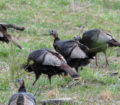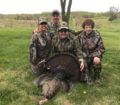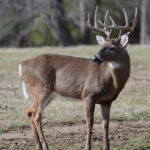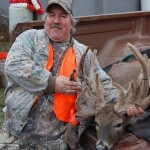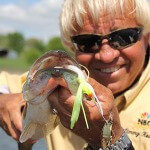Editor’s Note: Editor’s Note: Since some states’ turkey seasons continue through the first part of May, and others don’t end until May 31st or even in June, we’re looking this week at more ways to take turkeys. Alex Rutledge of Birch Tree, Missouri, has hunted and called turkeys for over 30 years.
 Question: Alex, how far can you call a turkey?
Question: Alex, how far can you call a turkey?
Rutledge: I’ve called turkeys to within the very edge of my hearing. Often, I barely could hear them when I started calling to them, which was maybe as far as 3/4-mile away. I’ve had turkeys fly off bluffs and across rivers to reach me. If that ole gobbler’s lonely, and you’re making the right calls, he’ll travel a long way to get to you.
Question: What kind of calls are you using, and what are you trying to say to the turkey to pull that turkey 3/4-mile to you?
Rutledge: I want to use as little calling as I have to use to get that turkey to come to me. So, the first call I make to a long-distance gobbler is one that I hope he’ll be able to hear. If he can’t hear me gobbling, he won’t come. I feel that you can reach out further and touch a gobbler more effectively with a box call than you can with any other calls. I want to call really loudly and aggressively to let that gobbler know that I’m excited, and I’m ready to breed.
If I hear the turkey coming with his gobbling getting louder, I’ll stay right where I am, because the turkey’s doing exactly what I want him to do. I use this tactic, especially early in the season, when there aren’t many receptive hens available for the gobbler, because he’ll travel great distances to find the first hen that’s willing to breed. I also use this tactic when I’m hunting on private lands and know there’s no other hunters around me. I don’t want to call in other hunters and let them get between the gobbler and me or call in other receptive hens, if the gobbler may stop and breed before he gets to me. If it’s later in the season, when there are a lot of receptive hens around, or if I’m hunting on property where I’m concerned there may be other hunters between me and the gobbler, I’ll close the distance between me and the gobbler before I call to him a second time. However, remember you drastically increase your chances of spooking a gobbler when you know he’s coming to you, and you’re going to him. There’s a much-greater chance that he’ll hear or see you before you see him when you try to get closer to a bird that’s coming to you.
 Question: How do you get a turkey to fly across a river, Alex?
Question: How do you get a turkey to fly across a river, Alex?
Rutledge: I try to get him very hot and bothered. I’ll start off soft calling to him, and then I’ll build up the emotion of the calling by getting more aggressive by chuckling and crackling. If I can get that tom to start gobbling on his own and get really worked-up, I may spit and drum at him. I don’t use the gobble call until the turkey stops and refuses to come to me. That’s when I’ll challenge him with the gobbling. I’ll also throw in some jake calls and fighting purrs to make him think there’s more than one gobbler trying to breed these hens that have been calling to him.
If the gobbler that’s hung-up across the creek is a dominant gobbler, he’ll more than likely accept the challenge and fly across the creek to run off the other gobblers trying to breed his hens.
In the late 1980s, my nephew and I were hunting together, when we heard this turkey gobble 3/4-mile away. I started calling this turkey with a box call, and the more I called to him, the closer he got to a big bluff on the side of a ditch. Before I had to use any gobbles, the turkey flew off the bluff, landed in the middle of a county road and walked down the middle of that road to us. The bird came within 30 yards of us. Just before my nephew fired the shot, he moved, and the turkey spotted him. We didn’t get the bird, but we know the tactic worked. We just didn’t finish the deal.
 Many times, if you’ve got a gobbler coming to you that’s really fired-up and you shut-up so the gobbler can’t hear you, he’ll fly across the river to find you. The only time I use that gobble call is when that turkey hangs up across the river, demanding that the hen come to him.
Many times, if you’ve got a gobbler coming to you that’s really fired-up and you shut-up so the gobbler can’t hear you, he’ll fly across the river to find you. The only time I use that gobble call is when that turkey hangs up across the river, demanding that the hen come to him.
You have to play mind games with turkeys. When you’re trying to make a turkey cross some sort of terrain break that he doesn’t want to cross, get to a location where you’ve seen hens previously. If a gobbler knows that he’s been there before and hears calls coming from that area, he’s even more convinced that he should go there and try to meet up with his hens. That can be a key ingredient to making a gobbler come to a place that he doesn’t really want to come to, or to exert more energy than he really wants to expend.
To learn more about turkey hunting, check out John E. Phillips’ print, Audible, Kindle and Nook turkey books at https://johninthewild.com/books/#turkey and at www.barnesandnoble.com. You also can download a free Kindle app that enables you to read the book on your iPad, computer or SmartPhone. You can learn more about calling turkeys by going to johninthewild.com/audio-files/ for audio turkey tapes to purchase of Lovett Williams, Rob Keck and Chris Kirby, available for download to your SmartPhone, tablet or computer. For a free copy of John E. Phillips’ “The Turkey Gobbler Getter Manual,” go to https://johninthewild.com/free-books/ to download.

